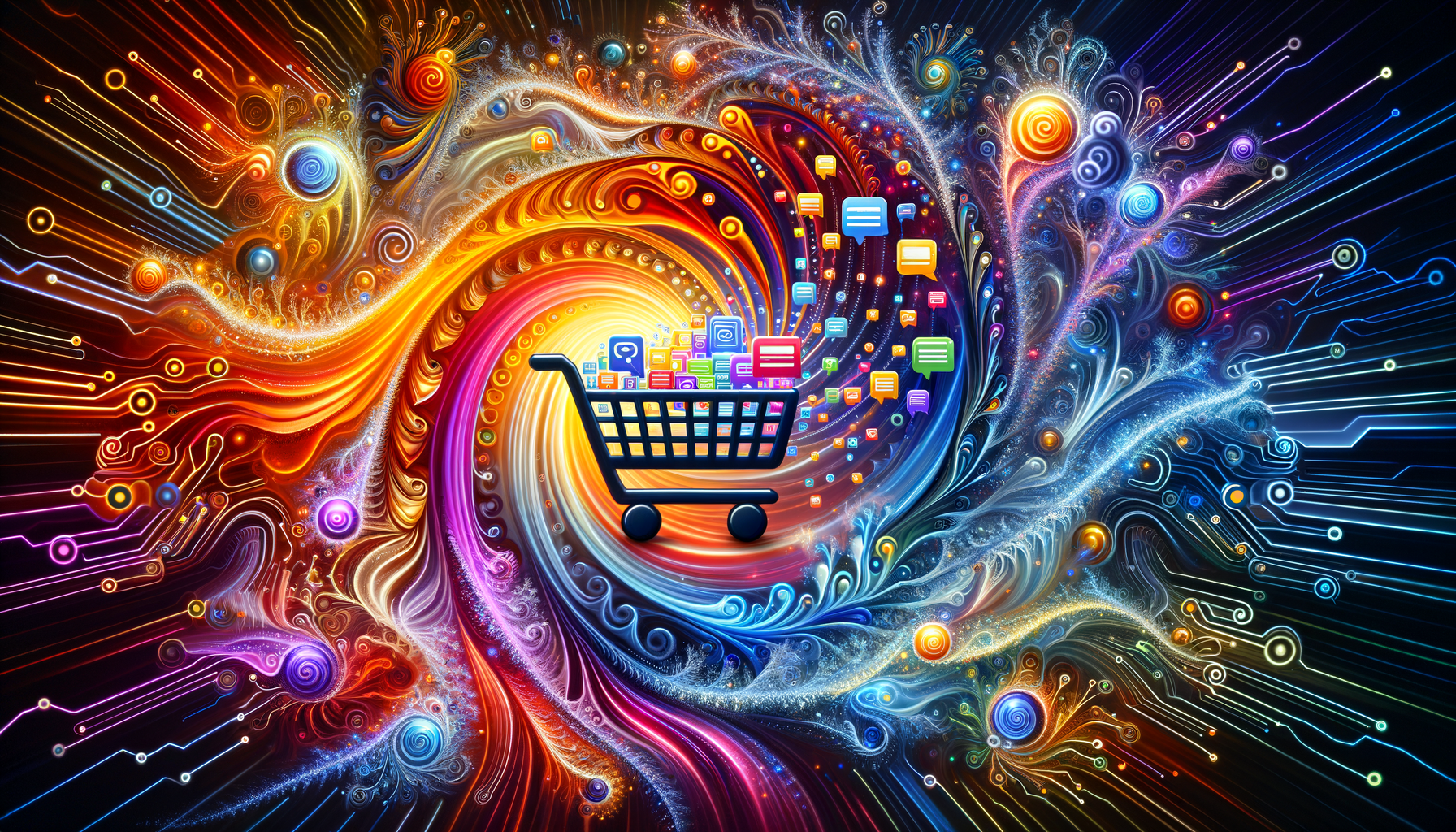In today’s fast-paced retail environment, retail chatbots are emerging as a game-changing solution for enhancing customer service. These innovative tools not only streamline interactions but also provide personalized experiences that cater to the unique needs of shoppers. In this article, we will delve into the fundamentals of chatbots in retail, exploring what a retail chatbot is and the key features that make them indispensable for modern businesses. We will also examine successful implementations, such as the chatbot used by Walmart, and how it enhances customer service. Additionally, we will guide you through the process of creating your own retail bot, discuss the various types of chatbots available, and highlight the transformative impact these technologies have on the retail industry. By the end of this article, you will understand why investing in customer care chatbots is essential for staying competitive in the evolving retail landscape.
What is a retail chatbot?
A retail chatbot is an advanced digital assistant designed to enhance the shopping experience by providing personalized support and recommendations to customers. These chatbots utilize artificial intelligence (AI) and machine learning algorithms to analyze customer data, including past purchases, browsing behavior, and preferences, to deliver tailored product suggestions.
Understanding the Basics of Retail Chatbots
Retail chatbots are revolutionizing the way businesses interact with their customers. By leveraging AI technology, these chatbots can engage customers in real-time, offering assistance and information that enhances the overall shopping experience. Here are some key features that define retail chatbots:
- Personalized Recommendations: By leveraging customer data, retail chatbots can suggest products that align with individual tastes, increasing the likelihood of conversion. A study by McKinsey & Company found that personalized experiences can lead to a 10-30% increase in sales.
- 24/7 Customer Support: Retail chatbots are available around the clock, providing instant responses to customer inquiries, which enhances customer satisfaction and reduces wait times. According to a report by IBM, businesses can save up to 30% in customer service costs by implementing chatbots.
- Seamless Integration: These chatbots can be integrated into various platforms, including websites, social media, and messaging apps, allowing customers to interact with brands through their preferred channels. This omnichannel approach is crucial for modern retail strategies.
- Data Collection and Insights: Retail chatbots collect valuable data on customer interactions, which can be analyzed to improve marketing strategies and product offerings. This data-driven approach enables retailers to stay ahead of market trends and consumer preferences.
- Enhanced User Engagement: By providing interactive and engaging experiences, retail chatbots can keep customers on the site longer, increasing the chances of purchase. Research indicates that interactive content can lead to higher engagement rates.
In conclusion, retail chatbots serve as a powerful tool for retailers looking to improve customer engagement, streamline operations, and boost sales through personalized shopping experiences. As the retail landscape continues to evolve, the adoption of AI-driven chatbots will likely become increasingly essential for success.
Key Features of Chatbots in Retail
Understanding the key features of chatbots in retail is essential for businesses aiming to enhance their customer service capabilities. Here are some of the standout features:
- Automated Responses: Chatbots can handle a multitude of inquiries simultaneously, providing quick answers to common questions, which significantly reduces the workload on human agents.
- Lead Generation: By engaging customers through personalized interactions, chatbots can effectively capture leads and guide them through the sales funnel.
- Multilingual Support: Many retail chatbots offer multilingual capabilities, allowing businesses to cater to a diverse customer base and enhance global reach.
- Analytics and Reporting: Retail chatbots provide insights into customer behavior and preferences, helping businesses refine their marketing strategies and improve customer service.
- Integration with E-Commerce Platforms: Retail chatbots can be integrated with e-commerce systems, enabling features like cart recovery and direct selling, which streamline the shopping process.
By incorporating these features, retail chatbots not only improve customer service but also drive sales and enhance brand loyalty.

What chatbot does Walmart use?
Walmart has embraced the power of artificial intelligence in customer service through its proprietary chatbot named Wallaby. This innovative solution is part of Walmart’s broader strategy to scale AI and generative AI technologies within its operations. Wallaby is specifically designed as a retail-focused Large Language Model (LLM), enabling it to enhance customer interactions by delivering personalized and efficient responses to inquiries. By leveraging advanced generative AI capabilities, Wallaby significantly improves customer care experiences, ensuring that Walmart can effectively meet the evolving needs of its shoppers.
The implementation of Wallaby showcases Walmart’s commitment to integrating cutting-edge technology into its customer service strategy. This initiative not only streamlines operations but also enhances user satisfaction, making it a vital component of Walmart’s approach to customer engagement. For further insights on Walmart’s AI initiatives, you can explore sources such as Forbes and TechCrunch.
How Walmart’s Chatbot Enhances Customer Service
Walmart’s Wallaby chatbot plays a crucial role in enhancing customer service by providing quick and accurate responses to customer inquiries. This chatbot is designed to handle a wide range of questions, from product availability to order tracking, thereby reducing wait times and improving the overall shopping experience. By utilizing a chatbot for customer service, Walmart can efficiently manage high volumes of customer interactions without compromising on quality.
Moreover, Wallaby’s ability to learn from interactions allows it to continuously improve its responses, adapting to customer preferences and behaviors over time. This adaptability is essential in the retail environment, where customer expectations are constantly evolving. By integrating Wallaby into its customer service framework, Walmart not only enhances operational efficiency but also fosters a more engaging and satisfying shopping experience for its customers. For more information on how AI chatbots are transforming customer service, check out our article on AI-powered customer service bots.
How to Make a Retail Bot?
Creating a retail chatbot involves several strategic steps that ensure it meets your business needs while enhancing customer interactions. By following a structured approach, you can develop a retail chatbot that effectively engages users and drives sales.
Step-by-Step Guide to Creating a Retail Chatbot
To build an effective retail bot, consider the following steps:
- Choose a Shopping Bot Platform: Select a robust shopping bot platform that suits your business needs. Popular options include Shopify, WooCommerce, and custom solutions like Dialogflow or Microsoft Bot Framework. Each platform offers unique features, so evaluate them based on scalability, ease of use, and integration capabilities.
- Define the Bot’s Purpose and Functionality: Clearly outline what tasks your shopping bot will perform. Common functionalities include product recommendations, order tracking, customer support, and personalized marketing. Understanding your target audience will help tailor the bot’s capabilities.
- Design the User Experience: Decide on the look and feel of your bot. Create an intuitive interface that aligns with your brand identity. Use conversational design principles to ensure the bot communicates effectively and engages users. Consider employing A/B testing to refine the user experience.
- Utilize Templates and Frameworks: Leverage pre-built templates available on your chosen platform to expedite the development process. These templates can provide a solid foundation for your bot, allowing you to customize features and workflows according to your specific requirements.
- Integrate with E-commerce Channels: Connect your shopping bot to various sales channels, including your website, social media platforms, and messaging apps like Facebook Messenger or WhatsApp. This omnichannel approach enhances customer accessibility and engagement.
- Train Your AI Shopping Chatbot: Implement machine learning algorithms to train your bot using historical customer interaction data. Regularly update the training dataset to improve the bot’s accuracy and responsiveness. Incorporate natural language processing (NLP) techniques to enhance understanding of customer queries.
- Monitor and Optimize Performance: Continuously track the bot’s performance using analytics tools. Monitor key metrics such as user engagement, conversion rates, and customer satisfaction. Use this data to make informed adjustments and improvements to your bot’s functionality.
By following these steps, you can create a highly effective retail bot that enhances customer experience and drives sales.
Tools and Platforms for Building Retail Chatbots
When it comes to building a chatbot for retail, several tools and platforms can facilitate the development process. Here are some popular options:
- Dialogflow: A Google-owned platform that offers powerful natural language processing capabilities, making it ideal for creating conversational interfaces.
- Microsoft Bot Framework: This framework provides a comprehensive set of tools for building and deploying chatbots across multiple channels.
- Chatfuel: A user-friendly platform that allows you to create chatbots for Facebook Messenger without any coding knowledge.
- ManyChat: Focused on marketing automation, ManyChat helps businesses engage customers through Facebook Messenger and SMS.
- Brain Pod AI: This platform offers advanced AI capabilities, including multilingual support and customizable templates, making it a strong contender for businesses looking to enhance their customer service chatbots. You can explore more about Brain Pod AI here.
Choosing the right platform is crucial for the success of your chatbots for retail. Evaluate each option based on your specific needs and the features they offer.
How Will Chatbots Transform the Retail Industry?
Chatbots are set to revolutionize the retail landscape by enhancing customer interactions and streamlining operations. As we delve into the impact of chatbots on customer experience, it becomes clear that these digital assistants are not just a trend but a fundamental shift in how retailers engage with their customers.
The Impact of Chatbots on Customer Experience
Retail chatbots are transforming the way customers interact with brands, providing a personalized shopping experience that caters to individual preferences. By leveraging advanced algorithms and machine learning, chatbots analyze customer data, preferences, and purchase history to offer tailored product recommendations and promotions. This level of personalization can lead to a significant increase in sales, with studies indicating a potential 10-30% boost in revenue from personalized experiences.
Moreover, chatbots enhance operational efficiency by automating routine inquiries and tasks. This allows retail staff to focus on more complex customer interactions and strategic initiatives. According to a report from Salesforce, 69% of consumers prefer chatbots for quick communication, underscoring their role in improving customer service efficiency. Additionally, chatbots provide 24/7 availability, ensuring that customers can receive assistance at any time, which significantly boosts customer satisfaction and retention rates. Research from HubSpot shows that 47% of consumers are open to purchasing items through a chatbot, highlighting their effectiveness in driving sales.
Future Trends in Retail Chatbots
The future of retail chatbots is bright, with several trends poised to shape their evolution. One key trend is the integration with other technologies. Retail chatbots can seamlessly connect with CRM systems, inventory management, and e-commerce platforms, creating a cohesive shopping experience. This integration not only enhances operational efficiency but also provides customers with real-time information about product availability and order status.
Furthermore, the ability of chatbots to collect valuable customer insights through interactions will become increasingly important. This data can inform marketing strategies and product development, leading to more effective business decisions. A report from Gartner suggests that by 2025, 75% of customer interactions will be powered by AI, including chatbots, emphasizing the growing reliance on these tools in retail.
As retailers continue to adopt chatbots, they will not only improve customer engagement but also realize substantial cost reductions. Implementing chatbots can lead to significant savings by reducing the need for extensive customer service teams. According to a study by Juniper Research, chatbots are expected to save businesses over $8 billion annually through improved customer service efficiency.
In conclusion, the integration of chatbots into retail operations is not just a technological advancement; it is a strategic move towards enhancing customer experiences and driving business growth. Retailers that embrace this transformation will be well-positioned to thrive in an increasingly competitive market.

What are the 4 types of chatbots?
Understanding the different types of chatbots is crucial for businesses looking to enhance their customer service and engagement strategies. Retail chatbots can be categorized into several types, each serving unique functions and purposes. Here’s an overview of the main types of chatbots used in retail:
Overview of Different Types of Chatbots for Retail
1. Rule-based Chatbots: These chatbots operate on predefined rules and scripts. They can only respond to specific commands or keywords, making them suitable for straightforward tasks like FAQs. Their limitations include a lack of understanding of natural language nuances.
2. Keyword Recognition-based Chatbots: Utilizing keyword recognition, these chatbots interpret user inputs by analyzing the keywords in a user’s message to provide relevant responses. While more flexible than rule-based chatbots, they still struggle with complex queries and context.
3. Menu-based Chatbots: These chatbots guide users through a series of predefined options or menus. Users select from available choices, making it easy to navigate services or information. This structure is effective for customer service scenarios where specific queries can be anticipated.
4. Contextual Chatbots (Intelligent Chatbots): Leveraging artificial intelligence and machine learning, these advanced chatbots understand context and user intent. They can engage in more natural conversations, learning from interactions to improve over time. Contextual chatbots are ideal for personalized customer experiences.
5. Hybrid Chatbots: Combining rule-based and AI-driven approaches, hybrid chatbots can handle both structured queries and more complex interactions. They offer flexibility and adaptability, making them suitable for a wide range of applications.
6. Voice-enabled Chatbots: These chatbots utilize voice recognition technology to interact with users through spoken language. They are increasingly popular in smart devices and virtual assistants, providing hands-free convenience.
7. Declarative Chatbots: Allowing users to make statements or requests in natural language, these chatbots interpret the intent behind the input, facilitating more fluid conversations.
8. Predictive Chatbots: Utilizing data analytics and machine learning, predictive chatbots anticipate user needs based on previous interactions, proactively offering assistance and enhancing user engagement.
Best Retail Chatbot Examples and Their Use Cases
Several brands have successfully implemented chatbots to improve their customer service and engagement. For instance, Walmart uses a sophisticated chatbot to assist customers with inquiries, making the shopping experience more efficient. Similarly, Amazon employs chatbots for customer support, streamlining the resolution of issues and enhancing user satisfaction.
Another notable example is Sephora, which utilizes a chatbot to provide personalized product recommendations, helping customers find the right products based on their preferences. These implementations showcase how chatbots can effectively enhance customer care and streamline retail operations.
For businesses looking to explore chatbot solutions, platforms like Brain Pod AI offer advanced chatbot functionalities that can be tailored to specific retail needs, enhancing customer interactions and support.
For further insights into the impact of chatbots in retail, you can explore our article on best AI chatbots and conversational AI examples.
Can You Make Money Selling Chatbots?
Yes, you can make money selling chatbots through various strategies. Here are some effective methods to monetize your chatbot:
- Direct Sales: Develop and sell your chatbot directly to businesses. Many companies are looking to enhance customer engagement and streamline operations through automation. By creating a tailored chatbot that meets specific business needs, you can charge a premium price. According to a report by Grand View Research, the global chatbot market is expected to reach $1.34 billion by 2024, indicating a growing demand for these solutions.
- Subscription Model: Offer your chatbot as a subscription service. Businesses can pay a monthly fee to access and utilize your chatbot, providing a steady revenue stream. This model is particularly effective for chatbots that require regular updates and maintenance.
- Affiliate Marketing: Partner with businesses to promote their products or services through your chatbot. You can earn commissions on sales generated through your chatbot’s recommendations. This approach not only provides income but also enhances the chatbot’s value to users by offering relevant products.
- Freemium Model: Provide a basic version of your chatbot for free while charging for premium features. This strategy can attract a larger user base, and once users see the value of your chatbot, many may opt for the paid version.
- Consulting Services: Leverage your expertise in chatbot development by offering consulting services to businesses looking to implement chatbots. This can include strategy development, integration with existing systems, and ongoing support.
- Training and Workshops: Conduct training sessions or workshops for businesses interested in developing their own chatbots. This not only positions you as an expert in the field but also generates additional income.
- Customization and Integration: Offer customization services for existing chatbot platforms. Many businesses require specific functionalities that off-the-shelf solutions do not provide. By offering tailored integrations, you can charge for your expertise.
By employing these strategies, you can effectively monetize your chatbot and tap into the growing market for automated solutions. For more insights on chatbot monetization, refer to sources like Chatbot Magazine and the International Journal of Information Management, which provide valuable information on industry trends and best practices.
Success Stories of Selling Chatbots for Customer Support
Numerous businesses have successfully monetized chatbots, particularly in the realm of customer support. For instance, companies like Zendesk and Intercom have leveraged chatbots to enhance their customer service offerings. These platforms not only provide chatbots for customer service but also integrate advanced analytics to help businesses understand customer interactions better.
Additionally, many small businesses have reported significant improvements in customer satisfaction and operational efficiency after implementing chatbots. By automating responses to frequently asked questions and providing 24/7 support, these businesses have been able to reduce operational costs while improving customer engagement.
For example, a retail company that integrated a chatbot for customer support saw a 30% increase in customer satisfaction ratings and a 25% reduction in response times. Such success stories highlight the potential of chatbots not only as a revenue-generating tool but also as a means to enhance overall customer experience in the retail sector.
Conclusion
As we look toward the future of retail, the role of chatbots in enhancing customer service is becoming increasingly vital. Retail chatbots are not just a trend; they represent a fundamental shift in how businesses interact with their customers. By leveraging advanced AI technologies, these chatbots can provide personalized, efficient, and round-the-clock support, significantly improving the overall customer experience.
The Future of Chatbots in Retail and Customer Service
The future of chatbots in retail is bright, with continuous advancements in artificial intelligence and machine learning. Retail chatbots are expected to evolve, becoming more intuitive and capable of handling complex customer inquiries. This evolution will lead to even greater integration of chatbots into various retail platforms, enhancing customer engagement and satisfaction. Companies like Brain Pod AI are at the forefront of this innovation, offering sophisticated AI solutions that can be tailored to meet the specific needs of retail businesses.
Why Investing in Chatbots for Customer Care is Essential
Investing in chatbots for customer care is essential for retailers aiming to stay competitive in a rapidly changing market. Chatbots for customer service not only streamline operations but also provide valuable insights into customer behavior and preferences. By implementing a customer support chatbot, businesses can enhance their service offerings, reduce response times, and ultimately drive sales. As more consumers expect instant responses and personalized experiences, the integration of chatbots in retail will become a necessity rather than an option.




